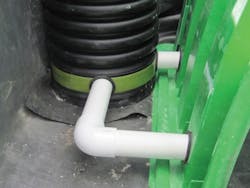There was a time when speaking of “storm water management” was a bit of lily gilding. Digging a trench to capture runoff from a development site, or lining swales to direct outflow to culverts, were hardly scientific endeavors.
Today, however, the control aspect of storm water management is the straw that stirs the drink. Developers now are asked not only to create world-class projects, but also to replicate natural hydrology, protect important features, and treat, store and reuse water at the same time. In many cases, the storm water management aspects of a project require as much planning as the architectural design.
The truth of this can be found in the growing number of storm water management and treatment systems available and the increased focus on storm water in codes and regulations; yet, to the uninitiated, the importance of storm water management is somewhat belied by its lack of visibility. Like an umpire that calls an outstanding baseball game, great storm water management often is marked by the fact that it does not stand out at all.
The ability to seamlessly integrate technology into a site design has never been greater. Most of the heavy lifting done by modern storm water management systems is performed not only behind the scenes, but under the topsoil.
Development projects now are utilizing underground chambers, which work in tandem with a variety of filtration and treatment systems to create storage and reuse options that are limited only by the design team’s imagination.
Further, not only do underground treatment and storage systems offer a wide array of design possibilities, but they also eliminate long-standing problems associated with above-ground storage ponds, including liability issues, pest issues and land-loss issues.
Cases in Point
The following are some examples of installations using the Triton Stormwater Solutions system.
When the Scarsdale Veterinary Hospital in Derby, U.K., looked to upgrade its storm water system to meet Britain’s stringent new standards (30-year rainfall event storage), it used Triton’s underground storage capacity to help keep the project on time, within budget and within the small site footprint.
Similarly, when Minneapolis-based 3M Corp. facilitated a community walking path to coincide with an expansion of its headquarters building, it relied on a Triton underground chamber system to provide the needed storage. Not only did the system have to replicate the area’s natural hydrology and sync up to an existing outflow pipe to a local stream, but due to existing infrastructure, it also needed to tuck into an asymmetrical trench and allow for pretreatment of entering storm water. Because of the complications, the developers sought an underground system that could adapt to the conditions encountered.
“The flexibility of the Triton system was an important consideration,” said Lance Hoff of Royal Enterprises, a Triton distributor that helped to design the layout and sold the product to 3M. “You’re really only limited by your imagination.”
For example, the University of Hawaii faced a challenge when administrators wanted to expand the school’s biological sciences building, but also preserve a historic tree that sat precariously close to the development site. In the end, planners were able to design the system around the tree, and achieve the necessary storage in a smaller footprint than would have been possible, by using a double-stack of underground chambers—essentially doubling the storage volume by utilizing vertical space rather than expanding the storage field’s landscape.
Additionally, the Evans Greenhouse project called on the development team to harness the rainwater falling at the Nevada site to be reused for plant irrigation, and also as a reserve for the local fire department to use in emergencies. Surface storage was not an option, both because it would gobble up land, and because evaporation would eradicate any collected water. Ultimately, the storm water management system designers were able to harvest 17,360 gal of reusable water from just 7 in. of annual rainfall by using underground chambers.
The systems are flexible in physical design and adaptive capability and were able to be installed in each of these cases in less than one day. Given new technologies like these and other tools, site development professionals are able to better protect the environment and preserve significant natural features, while still keeping project costs and timelines in balance.
Project manager Graham Smith noted after the Scarsdale project, “It took much longer to backfill than it did to actually place the chambers. The entire project was done in four days.”
Modern storm water management systems can perform functions once never even imagined and overcome hurdles that a few short years ago may have stymied developers, and can help make low-impact and truly sustainable development a reality.
Download: Here


